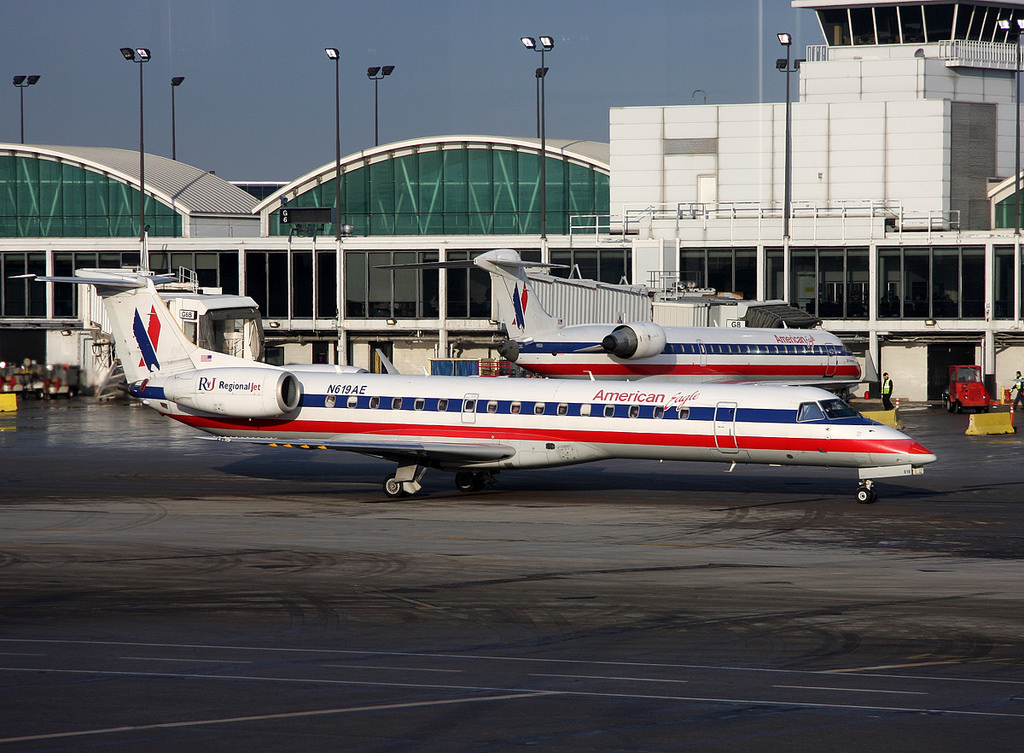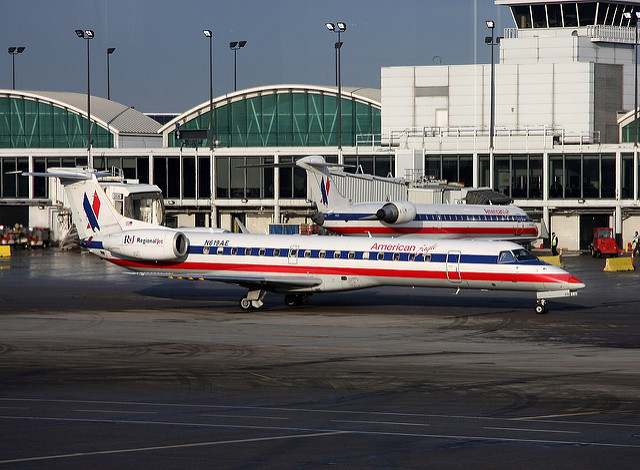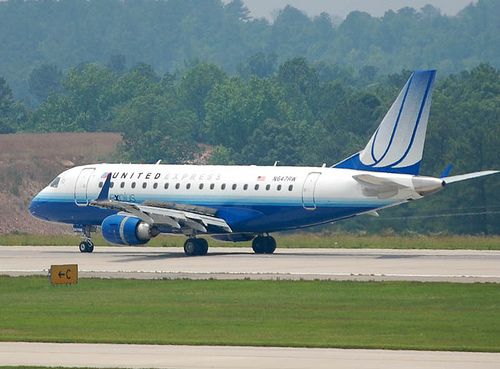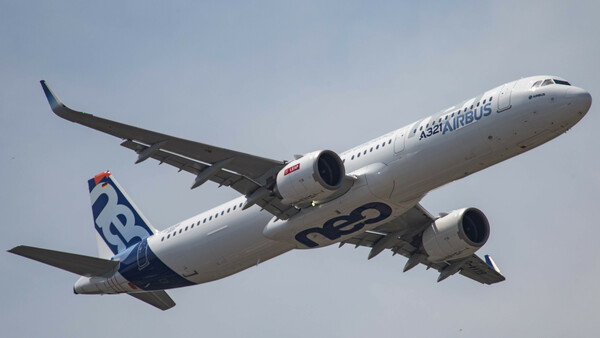Envoy E145 at Chicago on Nov 11th 2019, runway excursion on landing
Last Update: February 6, 2023 / 20:57:16 GMT/Zulu time
Incident Facts
Date of incident
Nov 11, 2019
Classification
Accident
Airline
Envoy Air
Flight number
AA-4125
Departure
Greensboro, United States
Destination
Chicago O'Hare, United States
Aircraft Registration
N619AE
Aircraft Type
Embraer ERJ-145
ICAO Type Designator
E145
Airport ICAO Code
KORD
The runway was closed.
The airline reported the aircraft skidded off the runway due to icy conditions at Chicago O'Hare, all 38 passengers and 3 crew left the aircraft without injuries and have been taken to the terminal.
Following the occurrence ATC changed to tell arriving aircraft that braking action was poor.
The aircraft had gone around on short final to runway 10L about 25 minutes earlier after being instructed by tower to go around.
On Nov 12th 2019 the FAA reported: "AIRCRAFT EXPERIENCED A RIGHT MAIN LANDING GEAR COLLAPSE ON LANDING AND SLID OFF THE RUNWAY, CHICAGO, IL". The aircraft received substantial damage, the occurrence was rated an accident.
On Mar 3rd 2020 the NTSB reported they are investigating the occurrence rated an accident. The NTSB wrote: "On November 11, 2019, at about 0742 CST, American Eagle flight 4125, operated by Envoy Air, an EMB145LR, N169AE, experienced a right main landing gear collapse after the aircraft departed runway 10L while landing at Chicago O'Hare International Airport (KORD), Chicago, Illinois. There were no injuries to the 41 passengers and crew onboard and the airplane received substantial damage. There was blowing snow at the time of the accident. The flight was operating under14 CFR part 121 as a domestic passenger flight from Piedmont Triad International Airport (KGSO), Greensboro, North Carolina."
On Dec 16th 2022 the NTSB opened their investigation docket.
The operational factors specialist report states summarizing the captain's testimony:
The flight was vectored by Chicago approach control for another approach to runway 10L. The flight intercepted the localizer and glideslope to runway 10L. The crew reported that the approach was stable, and they broke out of the clouds around 500 ft above ground level. The autopilot was disengaged, the wind was from 350° at 15 kts with gust to 20 kts, and they observed there was snow on the runway. The landing was “normal,” the captain reported he applied brakes, and as the airplane approach 80 kts it began “swerving” to the right. The FO called “centerline” and the captain applied corrections, including maximum reverse thrust and brakes. The airplane returned to the centerline, and then veered to the left. The captain again applied corrections and as the airplane began to correct back towards the centerline but it then “swerved more to the left.” The aircraft was decelerating through 50 kts when it experienced “an uncommanded swerve toward the taxi turn off N1” and departed the runway. The right main landing gear collapsed after the airplane departed the paved surface.
The FDR factual report stated:
The data begins at 07:41:10 when the aircraft is on its second final approach to runway 10L at KORD. At the beginning of the plot the data show the radio altitude was 518 feet AGL, the autopilot was engaged, and the indicated airspeed was approximately 146 knots. The first gear WOW indication was 47 seconds later, at 07:41:57. Three seconds after the aircraft touched down the inboard and outboard wheel brake pressure began to increase. Five seconds after touchdown, at 07:42:02, all four thrust reverser halves indicated deployed. The ground speed was 127 knots. At 07:42:15, with thrust reversers still deployed, inboard wheel brake pressure at approximately 340 psi, and outboard wheel brake pressure at 90 psi, the aircraft began to turn to the left. As the aircraft slowed to 39 knots, the thrust reversers indicated stowed at 07:42:23. As the reversers stowed, inboard and outboard wheel brake pressure increased, and the aircraft continued to turn to the left.
Two seconds later, at 07:42:29, a spike in vertical acceleration of 1.64 g and lateral acceleration of -0.85 g was recorded. Two seconds later, at 07;42:41 the gear WOW indication switched from ground to air. Ground speed was 12 knots. The plot ends at 07:42:40 after the ground speed indicated zero and the aircraft was at rest.
On Feb 6th 2023 the NTSB released their final report concluding the probable causes of the accident were:
The flight crew’s inability to maintain the airplane on the runway centerline after touchdown due to the reduced braking action resulting from the deteriorating weather conditions, which caused the airplane’s departure from the runway surface. Contributing to the accident were the delay in performing the runway assessment for undetermined reasons and failure to close the runway. Also contributing to the accident was the controller’s failure to advise the accident flight crew that braking action was no longer consistent with the previously published notice to air mission, which described braking action as good across all three runway zones.
The NTSB analysed:
While the airplane was on short final approach to runway 10L, the tower controller issued instructions to the accident flight crew to go-around. (The controller did not provide a reason for the go-around instruction.) The flight crew performed a go-around maneuver and subsequently discussed, with the company dispatcher, the possibility of diverting to the alternate airport or changing the alternate airport to one closer to the airplane’s position. However, the flight crew elected to make another approach to the destination airport.
During the second approach to runway 10L, the tower controller informed the flight crew that the runway condition code was 5/5/5, which indicated “good” braking action across all three runway zones (touchdown/midpoint/rollout). However, the controller also informed the crew that other flight crews had reported the braking action as “medium to poor” until taxiway N3 (which was located about halfway down the runway) and then “poor” past that point. The controller cleared the airplane to land and reported that the wind was from 360° at 17 knots with gusts to 24 knots. Given the runway orientation, the steady-state wind speed would have resulted in a crosswind component of about 16 knots. The company’s maximum crosswind limit during landing was 30 knots for a dry runway or if the braking action is reported as “good”.
The airplane touched down on the runway centerline, but, as the captain applied the brakes and reverse thrust, the airplane moved off the centerline. The crew stated the airplane started swerving to the right when its indicated airspeed was about 80 knots. As the captain applied corrections to maneuver back to the centerline, the airplane started to slide to the left. The captain stated that he applied maximum reverse power and brakes but that the airplane continued to slide to the left.
Flight data recorder (FDR) data indicated that after landing, thrust reverser deployment and brake application, the airplane was tracking slightly right when the captain was commanding slightly left. At 80 knots, the airplane veered to the left and the captain commanded airplane nose right rudder. However, rudder effectiveness at slower airspeeds and with thrust reversers is reduced and the left turn was not arrested. Data also shows that no more than +/- 3 degrees of rudder deflection was used.
The first officer stated that the airplane “experienced an uncommanded swerve” to the left near taxiway N1, which was about one-third of the way down the runway from the approach end. The airplane subsequently slid off the runway at an airspeed of about 60 knots and onto the grass on the left side of the runway. Postaccident examination of the airplane systems revealed no anomalies that would have precluded normal operation.
Light wet snow had started falling at the airport about 3.5 hours before the time of the accident, and about 1.6 inches of snow accumulation was reported at 0600. Clearing operations had been performed on runway 10L, and it was reopened about 1.5 hours before the accident with a runway condition code of 5/5/5 and conditions assessed as 90% wet and 10% with 1/8 inch of wet snow across all three runway zones. A field condition notice to air mission reflecting those conditions was issued at 0624. Given that light wet snow was falling at the time, a reassessment of the runway conditions needed to occur within 90 minutes of the previous assessment, and a 90-minute pavement inspection timer was set in the air traffic control tower.
As snow clearing operations on runway 10L were concluding, airport operations personnel began conducted clearing operations on the two other parallel runways (10C and 10R) on the south side of the airport. Runway 10C remained closed until about 3 minutes before the accident, and runway 10R had not been reopened at the time of the accident because conditions on that runway had not yet improved. Thus, at the time that the accident flight was cleared to land, runway 10L was the only runway on the south side of the airport being used for landing operations.
As previously stated, the tower controller informed the flight crew that the reported braking action for runway 10L was “medium to poor” until taxiway N3 and “poor” past that point. According to Envoy Air’s EMB-140/145 Aircraft Operations Manual, which contained Federal Aviation Administration guidance about runway condition assessments, a pilot report of medium indicated that braking deceleration or directional control was “noticeably reduced,” and a pilot report of poor indicated that braking deceleration or directional control was “significantly reduced.” Both the captain and the first officer indicated that, according to company guidance, the Runway condition codes are “controlling” and that pilot reports are advisory. Thus, it was reasonable for the flight crew to attempt to land on the runway based on the reported Runway condition code of 5/5/5.
The captain’s use of maximum reverse thrust and braking appeared to be consistent with his training. Specifically, the captain stated that he was trained to land on a contaminated runway by applying the brakes evenly and using maximum reverse until the airplane decelerated to about 80 knots. Envoy Air’s guidance stated that reverse thrust was the best aid in stopping on slippery runways and that high levels of symmetrical reverse thrust early in the landing roll would provide the most stopping force.
The captain also stated that he was trained that rudder effectiveness was reduced when using reverse thrust. In this case, the reduced rudder effectiveness was appropriate because the flight crew’s use of reverse thrust helped slow the airplane. Additionally, Envoy Air’s guidance stated that, at lower speeds, nosewheel steering and differential braking would be primarily used for directional control. In this case, the use of the differential braking and nosewheel steering might have helped the airplane track along the runway centerline, but the airplane’s stopping time (and distance) would likely have increased.
After runway 10L reopened at 0618, the controller requested braking action reports from landing airplanes. The flight crew of the first airplane to land on the runway reported braking action as poor. Multiple flight crews of airplanes that landed afterward reported that braking action was medium until taxiway N3 and poor after that point. One flight crew reported that it became “really hard to hold the centerline” after taxiway N3 because of the crosswind. Further, as the controller was issuing instructions to a flight crew for exiting the runway, she described the conditions at taxiway N3 as “slick.” Thus, the conditions on runway 10L had deteriorated and were no longer consistent with the previously published field condition NOTAM indicating that the Runway condition code was 5/5/5.
The airport’s Snow and Ice Control Plan stated that two consecutive reports of poor braking action would trigger either a runway closure or a runway assessment. Although two consecutive reports of poor braking action were not received for the touchdown zone of the runway, multiple reports of poor braking action reports were received for the midpoint zone, which were not consistent with the airport’s previous assessment of the runway.
The southside snow coordinator had been monitoring the status of runway 10L from the air traffic control tower and was aware of the reports of medium and poor braking action. About 0730 (and with about 60 minutes of the 90-minute pavement inspection timer elapsed), he dispatched two airport operations supervisors in two vehicles to conduct friction and condition assessments of runway 10L. One of the supervisors requested clearance onto the runway, but the controller instructed both vehicles to hold short of the runway at their position (taxiway Z). About 2 minutes later, the other supervisor notified the controller that both vehicles were holding short of runway 10L, and the controller acknowledged this information and repeated the hold-short instruction. The accident occurred about 7 minutes 17 seconds after the first airport operations supervisor initially requested access to the runway.
Although airport operations supervisors were standing by to conduct an assessment of runway 10L before the 90-minute pavement inspection timer had elapsed, the available evidence for this accident precluded a determination of why the vehicles were not cleared onto the runway before the accident landing.
Related NOTAM:
11/410 (A2032/19) - RWY 10L/28R CLSD. 11 NOV 13:44 2019 UNTIL 11 NOV 18:00 2019. CREATED: 11 NOV 13:44 2019
Metars:
KORD 111451Z 34014G25KT 1/2SM R10L/4500V5500FT SN BLSN VV011 M06/M07 A3024 RMK AO2 PK WND 35027/1440 SLP247 SNINCR 1/3 P0001 60003 T10561067 53019 $=
KORD 111351Z 35017G26KT 3/4SM R10L/4000V5000FT -SN BLSN VV011 M05/M06 A3022 RMK AO2 PK WND 35028/1331 SLP240 P0001 T10501061 $=
KORD 111302Z 35013G25KT 3/4SM R10L/4000V5500FT -SN BLSN VV010 M05/M06 A3019 RMK AO2 P0001 T10501061 $=
KORD 111251Z 35016G22KT 1SM R10L/5000VP6000FT -SN BLSN VV011 M04/M06 A3019 RMK AO2 PK WND 35027/1211 SLP232 P0001 T10441061 $=
KORD 111225Z 35016KT 1SM R10L/P6000FT -SN BR VV011 M04/M06 A3019 RMK AO2 PK WND 35027/1211 P0001 T10441056 $=
KORD 111217Z 35015G27KT 3/4SM R10L/P6000FT -SN BR VV009 M04/M06 A3018 RMK AO2 PK WND 35027/1211 P0001 T10441056 $=
KORD 111151Z 35016G25KT 3/4SM R10L/P6000FT -SN BR OVC009 M04/M05 A3018 RMK AO2 SLP227 P0001 60014 70018 T10391050 10006 21039 $=
KORD 111051Z 35013KT 3/4SM R10L/P6000FT -SN BR OVC007 M03/M03 A3017 RMK AO2 SLP224 P0002 T10281033 $=
KORD 110951Z 35013KT 3/4SM R10L/4000V5000FT -SN BR OVC007 M02/M02 A3015 RMK AO2 SLP218 P0004 T10171022 $=
Passenger video (Joseph Lian via CBS):
The FDR plot (Graphics: NTSB):
The aircraft just having come to a stop (Photo: Joseph Lian):
The aircraft on the ground:
Map (Graphics: AVH/Google Earth):
Aircraft Registration Data
Incident Facts
Date of incident
Nov 11, 2019
Classification
Accident
Airline
Envoy Air
Flight number
AA-4125
Departure
Greensboro, United States
Destination
Chicago O'Hare, United States
Aircraft Registration
N619AE
Aircraft Type
Embraer ERJ-145
ICAO Type Designator
E145
Airport ICAO Code
KORD
This article is published under license from Avherald.com. © of text by Avherald.com.
Article source
You can read 2 more free articles without a subscription.
Subscribe now and continue reading without any limits!
Read unlimited articles and receive our daily update briefing. Gain better insights into what is happening in commercial aviation safety.
Send tip
Support AeroInside by sending a small tip amount.
Related articles
Trans States E145 at Raleigh/Durham on Feb 12th 2017, engine leak
A Trans States Airlines Embraer ERJ-145 on behalf of American Airlines, registration N619AE performing flight AX-4315/AA-4315 from Raleigh/Durham,NC…
Envoy E175 at Dallas on Dec 6th 2025, engine failure
An Envoy Embraer ERJ-175 on behalf of American Airlines, registration N270NN performing flight AA-3939 from Dallas Ft. Worth,TX to Midland,TX (USA)…
Envoy E175 at Montgomery on Dec 31st 2022, ground worker killed
An Envoy Embraer ERJ-175 on behalf of American Airlines, registration N264NN performing flight AA-3408 from Montgomery,AL to Dallas Ft. Worth,TX…
Envoy E175 at Dallas on Nov 1st 2024, loss of nose gear steering
An Envoy Embraer ERJ-175 on behalf of American Airlines, registration N282NN performing flight AA-4174 from Little Rock,AR to Dallas Ft. Worth,TX…
Envoy E170 enroute on Aug 14th 2023, turbulence injures cabin crew
An Envoy Embraer ERJ-170, registration N776MS performing flight AA-3788 from Des Moines,IA to Chicago O'Hare,IL (USA), was enroute when the aircraft…
Envoy E175 at Washington on May 1st 2024, bird strike causes flap fail
An Envoy Embraer ERJ-175 on behalf of American Airlines, registration N205NN performing flight AA-4168 from Washington National,DC to Key West,FL…
Newest articles
Republic E170 at Savannah on Jan 8th 2026, smoke on flight deck
A Republic Airways Embraer ERJ-170 on behalf of United, registration N647RW performing flight UA-3496 from Chicago O'Hare,IL to Savannah,GA (USA)…
Indigo A21N at Gorakhpur on Jan 11th 2026, bird strike
An Indigo Airbus A321-200N, registration VT-IMR performing flight 6E-437 from Gorakhpur to Bangalore (India) with 216 people on board, was climbing…
Subscribe today
Are you researching aviation incidents? Get access to AeroInside Insights, unlimited read access and receive the daily newsletter.
Pick your plan and subscribePartner

ELITE Simulation Solutions is a leading global provider of Flight Simulation Training Devices, IFR training software as well as flight controls and related services. Find out more.
SafetyScan Pro provides streamlined access to thousands of aviation accident reports. Tailored for your safety management efforts. Book your demo today
AeroInside Blog
Popular aircraft
Airbus A320Boeing 737-800
Boeing 737-800 MAX
Popular airlines
American AirlinesUnited
Delta
Air Canada
Lufthansa
British Airways





